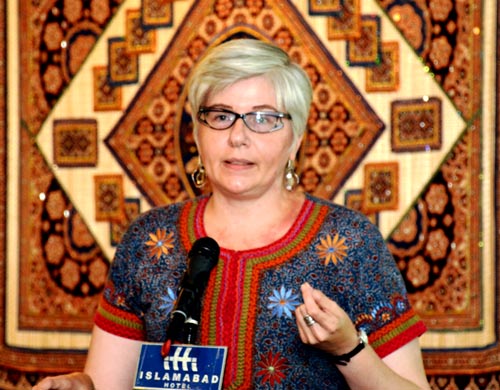Jennifer Johnson
A rural woman in Bangladesh cuts up feed for her family’s livestock.Photo: S. Mojumder/Drik/CIMMYT.
15 October 2014 will mark the sixth celebration of the International Day of Rural Women, a United Nations (UN) day dedicated to recognizing “the critical role and contribution of rural women, including indigenous women, in enhancing agricultural and rural development, improving food security and eradicating rural poverty.” The International Day of Rural Women was first celebrated on 15 October 2008, and was established by the UN General Assembly on 18 December 2007. CIMMYT acknowledges the importance of understanding and recognizing the important role of women in agriculture, and is committed to the inclusion and participation of women – especially rural women – in its research and programs.
“Rural women produce much of the world’s food, care for the environment and help reduce the risk of disaster in their communities. Yet they continue to face disadvantages and discrimination that prevent them from realizing their potential,” stated UN Secretary General Ban Ki Moon in his 2013 International Day of Rural Women message. “For too many rural women, their daily reality is one in which they do not own the land they farm, are denied the financial services that could lift them out of poverty, and live without the guarantee of basic nutrition, health services and amenities such as clean water and sanitation. Empowering rural women is crucial for ending hunger and poverty.”
According to the Food and Agriculture Organization (FAO) of the UN, women comprise about 43 percent of the agricultural labor force globally and in developing countries, but have limited access to productive resources and employment opportunities. This constrains their capacity to improve their lives and to better contribute to the economic growth, food security and sustainable development of their communities and countries. Research shows that if women in agriculture were afforded the same rights and opportunities as men, they could increase their farm yields by an estimated 20 to 30 percent and feed up to 150 million more people worldwide. Lack of access to important yield-increasing inputs such as improved seed, fertilizers and equipment frequently limits the agricultural yields rural women are able to produce. “Women are a key part of the mainstream in agriculture, yet they face formidable obstacles,” said CIMMYT gender and development specialist Vongai Kandiwa during a seminar in Nairobi, Kenya. “By closing the gap in access to technology between men and women, we could increase productivity by 30 percent.” This advance would help to improve child survival and nutrition, as “women are the key to household food security.”
“CIMMYT is working hard to close this gender gap and generate gains in agricultural output, food security, economic growth and social welfare,” reported CIMMYT’s Director General Thomas Lumpkin in his 2014 message for International Women’s Day. “Across our projects in Africa, Asia and Latin America, CIMMYT actively seeks women’s participation in breeding and seed sector development, the value chain and agricultural mechanization, and is working to integrate gender into the project design cycle and into project implementation. The CGIAR Research Programs (CRPs) on MAIZE and WHEAT (both led by CIMMYT) have an approved gender integration strategy and in 2014 and 2015 all CRPs will jointly conduct a cross-gender study.”
In addition, CIMMYT also works to improve rural women’s access to the inputs and tools they need to increase productivity, achieve higher yields and improve the economic well-being of their families. Projects implemented by CIMMYT across the developing world actively promote women’s participation and equality, such as the Cereal Systems Initiative for South Asia (CSISA), which has hired women staff members specifically to reach more women farmers and works to provide rural women with gender-responsive labor-saving technologies such as smaller hand seeders and power tillers. The Maize-Legume Systems for the Eastern Province of Zambia (SIMLEZA) and Drought Tolerant Maize for Africa (DTMA) projects in Africa have proactively sought to ensure women’s participation in decision-making by giving women the opportunity to present their ideas in women-only groups (which allow them more freedom and flexibility than mixed groups). The Take it to the Farmer (TTF) component of the Sustainable Modernization of Traditional Agriculture (MasAgro) program in Mexico has been using female field researchers and extension workers in order to be more inclusive of rural women in its projects. Ensuring the inclusion and participation of rural women in agricultural research and programs is crucial in the battle to improve their food security and livelihoods.
 Gender equality, youth and social inclusion
Gender equality, youth and social inclusion 